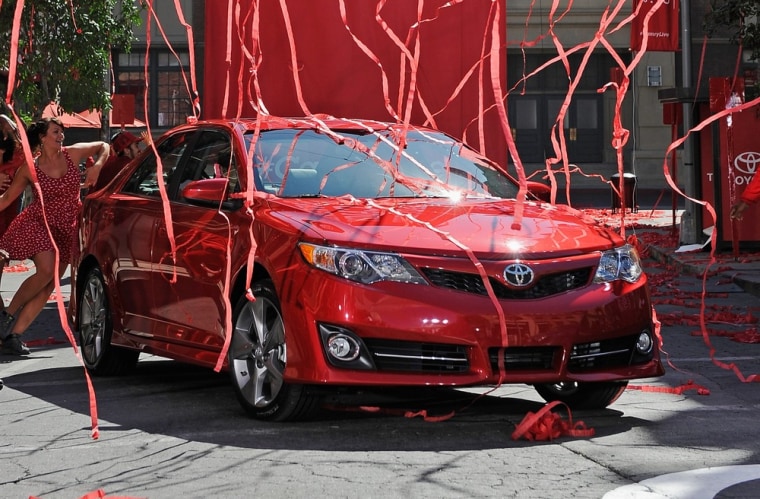“This launch is very important for our company,” proclaimed Akio Toyoda as he walked into the heart of the Georgetown, Ky., assembly plant that just started to build the new 2012 Toyota Camry.
“The car has become a symbol of Toyota’s success and an opportunity to show the world again what Toyota is all about,” he said.
The fact that Toyoda — the grandson of the Japanese automaker’s founder and himself the company’s current CEO — came to Kentucky only underscored the critical role of the new Camry. The sedan has been America’s best-selling passenger car for the last nine years running. But production shortages resulting from Japan’s March earthquake and tsunami make it less likely the Camry will repeat that feat for 2011.
The shortages, in fact, only complicate matters. Toyota is still trying to live down the quality and safety problems that seemed to land it unflattering headlines almost every week in 2010. While recent reports suggest those problems are on the mend — even as Toyota plants resume normal production — initial reviews of the new Camry can be charitably described as mixed.
Toyota isn’t the only Japanese car giant facing unexpectedly tough challenges. Honda was slammed by the March 11 natural disaster. Its new, 2012 Civic — as important to Honda as Camry is to Toyota — has been in short supply since its aborted spring launch, and the car won’t be back to normal inventory levels until the fall, according to John Mendel, the top U.S. executive at Honda of America.
The new Civic has also taken sharper blows from the media than the Camry. The highly influential Consumer Reports magazine recently declared that the redesigned subcompact now “ranks near the bottom of its category.”
That review is something the automaker takes "very seriously,” said Mike Accavitti, the new marketing chief for Honda.
How much of an impact the headlines will have on Toyota and Honda sales — once production is back to normal — remains to be seen. But industry analysts say there’s reason for the Japanese carmakers to worry.
The two automakers have some of the highest loyalty rates among new car buyers, but depending on current owners to carry things forward may be asking too much. Indeed, nearly half of Toyota and Honda sales still come from “conquests,” when a car shopper trades in a competitor’s product. And those are the car buyers most likely to be impacted by last year’s headlines and this year’s poor car reviews.
“A lot of people who buy Toyotas and Hondas look to Consumer Reports to validate their decisions about what to buy next,” said Dave Sullivan, automotive analyst with AutoPacific, Inc.
Bad reviews mean the two Japanese giants could “have a harder time” winning over the conquest buyers, “especially after they see what the new competition has to offer,” he added.
Traditionally rated at the back of the pack, cars made by U.S. and Korean automakers, such as the Ford Focus and Hyundai Elantra subcompacts, are suddenly winning rave reviews. The Chevrolet Cruze, the replacement for the unloved Chevy Cobalt, has recently landed at the top of the sales charts.
“The marketplace is a dogfight,” acknowledged Honda’s marketing chief Accavitti. “In all my years I haven’t ever seen so much competition in darn near every segment.”
Still, Accavitti insists that buyers will downplay criticism of the Civic — as well as a subsequent Consumer Reports article that took aim, more broadly, at Honda itself. The brand’s long-term reputation, he contends, “will drive buyers into the (Honda) showroom.”
Not everyone is so sanguine, however, and a number of analysts are betting that the conventional automotive order could be up for grabs over the next several years even after production levels return to normal.
That has led upstart carmakers — both domestic and Korean — to increase the pressure on their rivals. They’re rolling out more new products, adding more standard features and, in many cases, piling on the incentives to try to lure in once-loyal Toyota and Honda buyers while supplies of those carmakers’ cars are still short.
But Toyota is fighting back. It has started ratcheting up incentives in recent months and, significantly, it will drop the price on various Camry models by as much as $2,000 when the 2012 edition officially goes on sale in October.
That’s a difficult decision considering current exchange rates. At the currently lopsided 76 yen to the dollar, it’s almost impossible for Japanese carmakers to make money on cars imported from Japan — and even those assembled here, like the Camry, are penalized for every part imported from the home market.
But losing ground with Camry would be even more costly, and the carmaker will do everything it can to back up a promise by Toyota division boss Bob Carter that the midsize sedan “will continue to earn its position as America’s number one-selling passenger car.”
As for Honda, Accavitti insists his company won’t do what his former employer was prone to do — dump cars into low-profit car rental fleets just to make its sales numbers. Honda hasn’t ramped up incentives to the degree Toyota has, but that may be only a matter of time. The test will come this autumn when Honda effectively re-launches the new Civic with a major ad campaign.
Toyota, meanwhile, will attempt to overwhelm the critics with what Carter promises to be the most expensive launch budget in its history.
The industry giant has the muscle — and it will now need to use it more than ever. The era when Honda and Toyota could simply introduce new products and expect buyers to flood to the showrooms may be over.
